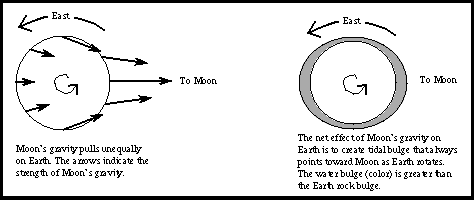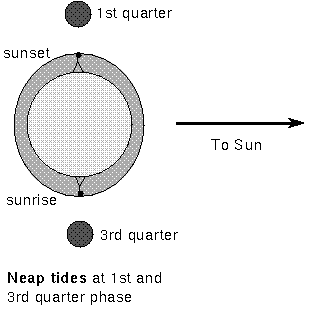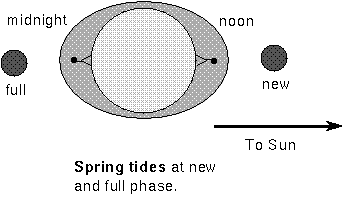
Video lecture for this chapter
When you look in the paper at the section containing the tide tables, you will often see the phase of the moon indicated as well. That is because the ocean tides are caused by different strengths of the Moon's gravity at different points on the Earth. The side of the Earth facing the Moon is about 6400 kilometers closer to the Moon than the center of the Earth is, and the Moon's gravity pulls on the near side of the Earth more strongly than on the Earth's center. This produces a tidal bulge on the side of the Earth facing the Moon. The Earth rock is not perfectly rigid; the side facing the Moon responds by rising toward the Moon by a few centimeters on the near side. The more fluid seawater responds by flowing into a bulge on the side of the Earth facing the Moon. That bulge is the high tide.
At the same time the Moon exerts an attractive force on the Earth's center that is stronger than that exerted on the side away from the Moon. The Moon pulls the Earth away from the oceans on the far side, which flow into a bulge on the far side, producing a second high tide on the far side.

These tidal bulges are always along the Earth-Moon line and the Earth rotates beneath the tidal bulge. When the part of the Earth where you are located sweeps under the bulges, you experience a high tide; when it passes under one of the depressions, you experience a low tide. An ideal coast should experience the rise and fall of the tides twice a day. In reality, the tidal cycle also depends on the latitude of the site, the shape of the shore, winds, etc.
The Sun's gravity also produces tides that are about half as strong as the Moon's and produces its own pair of tidal bulges. They combine with the lunar tides. At new and full moon, the Sun and Moon produce tidal bulges that add together to produce extreme tides. These are called spring tides (the waters really spring up!). When the Moon and Sun are at right angles to each other (1st & 3rd quarter), the solar tides reduce the lunar tides and you have neap tides.

|

|
Over the course of time this friction can have a noticeable effect. Astronomers trying to compare ancient solar eclipse records with their predictions found that they were off by a significant amount. But when they took the slowing down of the Earth's rotation into account, their predictions agreed with the solar eclipse records. Also, growth rings in ancient corals about 400 hundred million years old show that the day was only 22 hours long so that there were over 400 days in a year. In July 1996 a research study reported evidence, from several sedimentary rock records providing an indicator of tidal periods, that the day was only 18 hours long 900 million years ago.
Eventually the Earth's rotation will slow down to where it keeps only one face toward the Moon. Gravity acts both ways so the Earth has been creating tidal bulges on the Moon and has slowed it's rotation down so much that it rotates once every orbital period. The Moon keeps one face always toward the Earth.
Here is a list of references about the evidence for the slowing down of the Earth's rotation:

The consequence of the Moon's recession from the Earth because of the slowing down of the Earth's rotation is also an example of the conservation of angular momentum. Angular momentum is the amount of spin motion an object or group of objects has. It depends on the geometric size of the object or group of objects, how fast the object (or group of objects) is moving, and the mass of the object (or the group). Since the Earth's angular momentum is decreasing, the Moon's angular momentum must increase to keep the overall angular momentum of the Earth-Moon system the same. The concept of angular momentum is discussed further in the Angular Momentum appendix.
The slow spiraling out of the Moon means that there will come a time in the future when the angular size of the Moon will be smaller than the Sun's and we will not have any more total solar eclipses! Fifty billion years in the future the Earth day will equal 47 of our current days and the Moon will take 47 of our current days to orbit the Earth. Both will be locked with only one side facing the other---people on one side of the Earth will always see the Moon while people on the other side will only have legends about the Moon that left their pleasant sky.
| conservation of angular momentum | neap tide | spring tide |
|---|
last updated: February 21, 2022